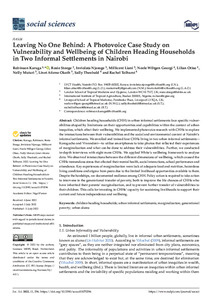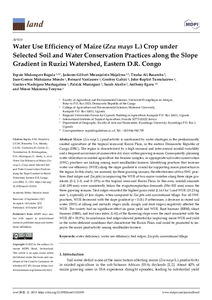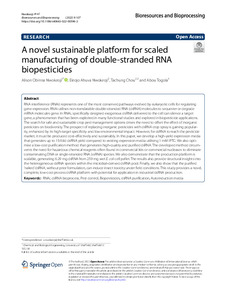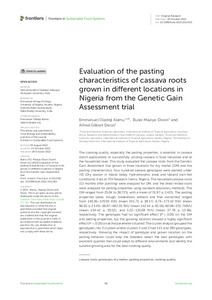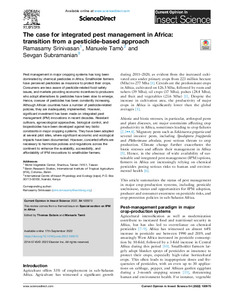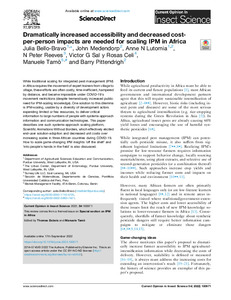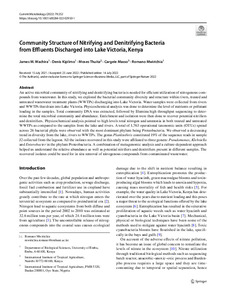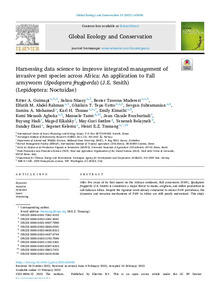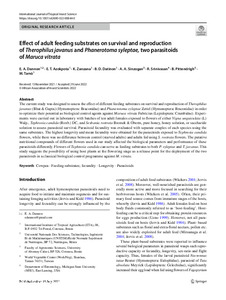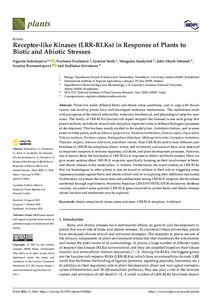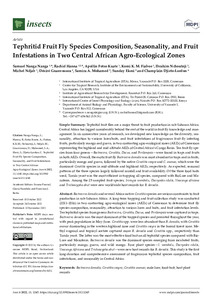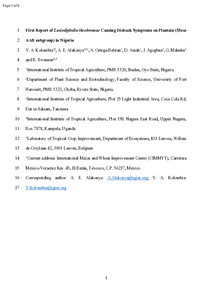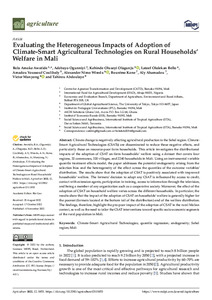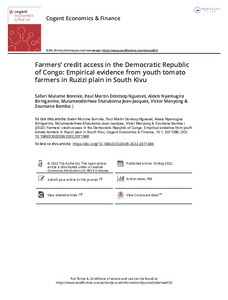Welcome to the International Institute of Tropical Agriculture Research Repository
Journal and Journal Articles: Recent submissions
Now showing items 361-380 of 5157
-
Plantain hybrids for the humid forest agroecology of Central Africa – diseases and pests load, fruit yield and farmers perception
(2022)Plantain is one of the major staples contributing to food security and income generation in West and Central Africa. Local cultivars in Cameroon are susceptible to pests and diseases causing severe losses in plantain production. This study aimed at evaluating the agronomic performance and producer’s perception of plantain hybrids in the humid forest of Cameroon. Field trials were established in a completely randomized block design with eight genotypes and three replicates. Data on pest and disease ... -
Leaving no one behind: a photovoice case study on vulnerability and wellbeing of children heading households in two informal settlements in Nairobi
(2022)Children heading households (CHH) in urban informal settlements face specific vulnerabilities shaped by limitations on their opportunities and capabilities within the context of urban inequities, which affect their wellbeing. We implemented photovoice research with CHHs to explore the intersections between their vulnerabilities and the social and environmental context of Nairobi’s informal settlements. We enrolled and trained four CHHs living in two urban informal settlements—Korogocho and ... -
Water use efficiency of maize (Zea mays L.) crop under selected soil and water conservation practices along the slope gradient in Ruzizi watershed, eastern D.R. Congo
(2022)Maize (Zea mays L.) productivity is constrained by water shortages in the predominantly rainfed agriculture of the tropical semi-arid Ruzizi Plain, in the eastern Democratic Republic of Congo (DRC). The region is characterized by a high seasonal and inter-annual rainfall variability and a frequent occurrence of consecutive dry days within growing seasons. Consequently, planning water utilization in rainfed agriculture has become complex, as appropriate soil water conservation (SWC) practices are ... -
A novel sustainable platform for scaled manufacturing of double‑stranded RNA biopesticides
(2022)RNA interference (RNAi) represents one of the most conserved pathways evolved by eukaryotic cells for regulating gene expression. RNAi utilises non-translatable double-stranded RNA (dsRNA) molecules to sequester or degrade mRNA molecules gene. In RNAi, specifically designed exogenous dsRNA delivered to the cell can silence a target gene, a phenomenon that has been exploited in many functional studies and explored in biopesticide applications. The search for safe and sustainable crop pest management ... -
Evaluation of the pasting characteristics of cassava roots grown in different locations in Nigeria from the Genetic Gain Assessment trial
(2022)The cooking quality, especially the pasting properties, is essential in cassava starch applications or successfully utilizing cassava in food industries and at the household level. This study evaluated the cassava roots from the Genetic Gain Assessment trial grown in three locations for dry matter (DM) and the pasting characteristics. Four hundred cassava genotypes were planted under IVS (Dry season in Inland Valley Hydromorphic area) and Upland (rain-fed conditions) trials at IITA Research Farms, ... -
How does IPM 3.0 look like (and why do we need it in Africa)?
(2022-10)The concept of Integrated Pest Management (IPM) was introduced sixty years ago to curb the overuse of agricultural pesticides, whereby its simplest version (IPM 1.0) was aiming at reducing the frequency of applications. Gradually, agro-ecological principles, such as biological control and habitat management, were included in IPM 2.0. However, throughout this time, smallholder farmers did not improve their decision-making skills and continue to use hazardous pesticides as their first control option. ... -
Determinants of smallholder farmers' willingness-to-pay for soyabean production inputs in northern Ghana
(2022-10)Farmers in northern Ghana have been cultivating soyabean with very little or no agro-inputs due to cost and limited accessibility. Use of quality agro-inputs can significantly improve the productivity of soyabean. This study assesses farmers’ current use of soyabean production agro-inputs, identifies challenges faced by smallholder farmers in soyabean cultivation and assesses factors influencing farmers’ willingness-to-pay (WTP) for soyabean inputs (determinants) in northern Ghana. Four hundred ... -
The case for integrated pest management in Africa: transition from a pesticide-based approach
(2022-12)Pest management in major cropping systems has long been dominated by chemical pesticides in Africa. Smallholder farmers have perceived pesticides as insurance to protect their crops. Consumers are less aware of pesticide-related food-safety issues, and markets providing economic incentives to producers who adopt alternatives to pesticides have been slow to emerge. Hence, overuse of pesticides has been constantly increasing. Although African countries have a number of pesticide-related policies, ... -
Dramatically increased accessibility and decreased cost- per-person impacts are needed for scaling IPM in Africa
(2022-12)While traditional scaling for integrated pest management (IPM) in Africa requires the movement of expert trainers from village to village, these efforts are often costly, time-inefficient, hampered by distance, and became impossible under COVID-19's movement restrictions (despite tremendously increased public need for IPM-scaling knowledge). One solution to this dilemma is IPM-scaling, usable by a diversity of development actors expending limited or few resources, to deliver critical information ... -
Community structure of nitrifying and denitrifying bacteria from effluents discharged into Lake Victoria, Kenya
(2022)An active microbial community of nitrifying and denitrifying bacteria is needed for efficient utilization of nitrogenous compounds from wastewater. In this study, we explored the bacterial community diversity and structure within rivers, treated and untreated wastewater treatment plants (WWTPs) discharging into Lake Victoria. Water samples were collected from rivers and WWTPs that drain into Lake Victoria. Physicochemical analysis was done to determine the level of nutrients or pollutant loading ... -
Harnessing data science to improve integrated management of invasive pest species across Africa: An application to Fall armyworm (Spodoptera frugiperda) (J.E. Smith) (Lepidoptera: Noctuidae)
(2022-06)After five years of its first report on the African continent, Fall armyworm (FAW), Spodoptera frugiperda (J.E. Smith) is considered a major threat to maize, sorghum, and millet production in sub-Saharan Africa. Despite the rigorous work already conducted to reduce FAW prevalence, the dynamics and invasion mechanisms of FAW in Africa are still poorly understood. This study applied interdisciplinary tools, analytics, and algorithms on a FAW dataset with a spatial lens to provide insights and project ... -
Effect of adult feeding substrates on survival and reproduction of Therophilus javanus and Phanerotoma syleptae, two parasitoids of Maruca vitrata
(2022)The current study was designed to assess the effect of different feeding substrates on survival and reproduction of Therophilus javanus (Bhat & Gupta) (Hymenoptera: Braconidae) and Phanerotoma syleptae Zettel (Hymenoptera: Braconidae) in order to optimize their potential as biological control agents against Maruca vitrata Fabricius (Lepidoptera: Crambidae). Experiments were carried out in laboratory with batches of ten adult females exposed to flowers of either Vigna unguiculata (L) Walp., Tephrosia ... -
Assessing lethal doses of the baculovirus MaviMNPV and the effect of its combination with neem oil on the survival of Maruca vitrata (Fabricius) (Lepidoptera: Crambidae) larval stages in laboratory
(2022)Cowpea production is limited by predation from several insect pests, including Maruca vitrata (F.) (Lepidoptera: Crambidae) as one of the most destructive. The present study aimed to assess the pesticidal effect of neem oil and the baculovirus MaviMNPV (separately and in combination) on M. vitrata under laboratory conditions. Eight treatments in a 4-replicate randomized block design (including control) were assessed at each of the five M. vitrata larval stages. Neem oil induced larval mortality ... -
Banana mapping in heterogenous smallholder farming systems using high-resolution remote sensing imagery and machine learning models with implications for banana bunchy top disease surveillance
(2022)Banana (and plantain, Musa spp.), in sub-Saharan Africa (SSA), is predominantly grown as a mixed crop by smallholder farmers in backyards and small farmlands, typically ranging from 0.2 ha to 3 ha. The crop is affected by several pests and diseases, including the invasive banana bunchy top virus (BBTV, genus Babuvirus), which is emerging as a major threat to banana production in SSA. The BBTV outbreak in West Africa was first recorded in the Benin Republic in 2010 and has spread to the adjoining ... -
Receptor-like Kinases (LRR-RLKs) in response of plants to biotic and abiotic stresses
(2022)Plants live under different biotic and abiotic stress conditions, and, to cope with the adversity and severity, plants have well-developed resistance mechanisms. The mechanism starts with perception of the stimuli followed by molecular, biochemical, and physiological adaptive measures. The family of LRR-RLKs (leucine-rich repeat receptor-like kinases) is one such group that perceives biotic and abiotic stimuli and also plays important roles in different biological processes of development. This ... -
A novel self-cleaving viroid-like RNA identified in RNA preparations from a citrus tree is not directly associated with the plant
(2022)Viroid and viroid-like satellite RNAs are infectious, circular, non-protein coding RNAs reported in plants only so far. Some viroids (family Avsunviroidae) and viroid-like satellite RNAs share self-cleaving activity mediated by hammerhead ribozymes (HHRzs) endowed in both RNA polarity strands. Using a homology-independent method based on the search for conserved structural motifs of HHRzs in reads and contigs from high-throughput sequenced RNAseq libraries, we identified a novel small (550 nt) ... -
Tephritid fruit fly species composition, seasonality, and fruit infestations in two central African agro-ecological zones
(2022-11-13)Bactrocera dorsalis and several Africa-native Ceratitis species are serious constraints to fruit production in sub-Saharan Africa. A long-term trapping and fruit collection study was conducted (2011–2016) in two contrasting agro-ecological zones (AEZs) of Cameroon to determine fruit fly species composition, seasonality, attraction to various lures and baits, and fruit infestation levels. Ten tephritid species from genera Bactrocera, Ceratitis, Dacus, and Perilampsis were captured in traps. Bactrocera ... -
Evaluating the heterogeneous impacts of adoption of climate-smart agricultural technologies on rural households' welfare in Mali
(2022-11-04)Climate change is negatively affecting agricultural production in the Sahel region. Climate-Smart Agricultural Technologies (CSATs) are disseminated to reduce these negative effects, and particularly those on resource-poor farm households. This article investigates the distributional impacts of the adoption of CSAT on-farm households’ welfare using a dataset that covers four regions, 32 communes, 320 villages, and 2240 households in Mali. Using an instrumental variable quantile treatment effects ... -
Farmers' credit access in the Democratic Republic of Congo: empirical evidence from youth tomato farmers in Ruzizi plain in south Kivu
(2022)This article assesses the opinions of youth tomato growers on the accessibility of agricultural credit and factors that influence the accessibility in the Democratic Republic of the Congo (DRC). Data originated from a household survey for the 2019/2020 farming season. We interviewed 218 youth tomato growers from 6 horticulture production zones in the South-Kivu, eastern DRC. The result reveals a low rate of 20.6% on accessing agricultural credit among tomato growers. The topmost nature of agricultural ...


